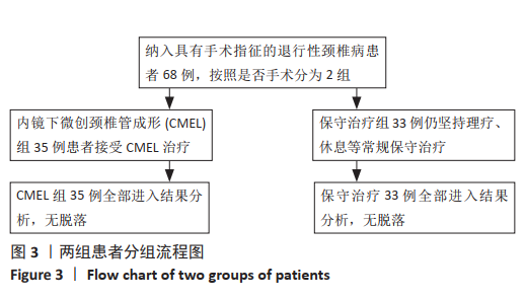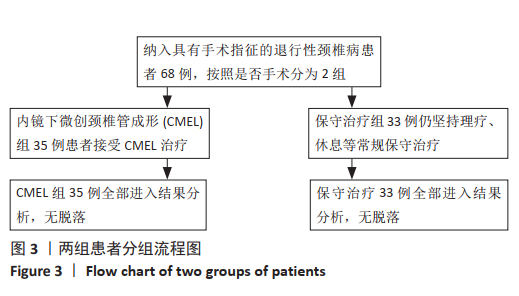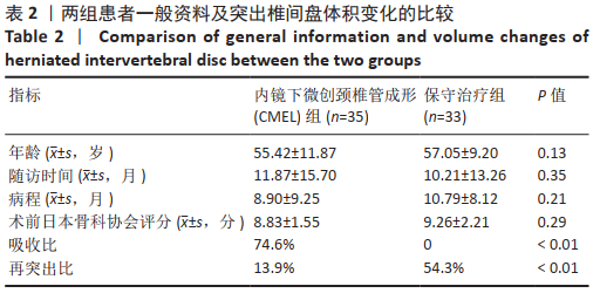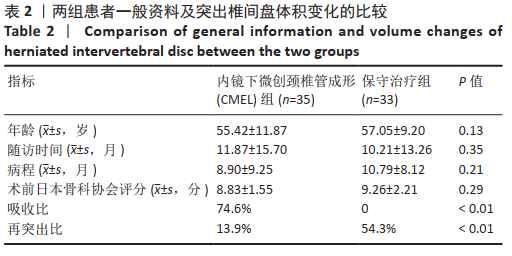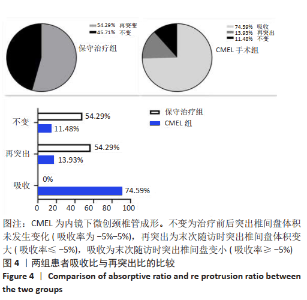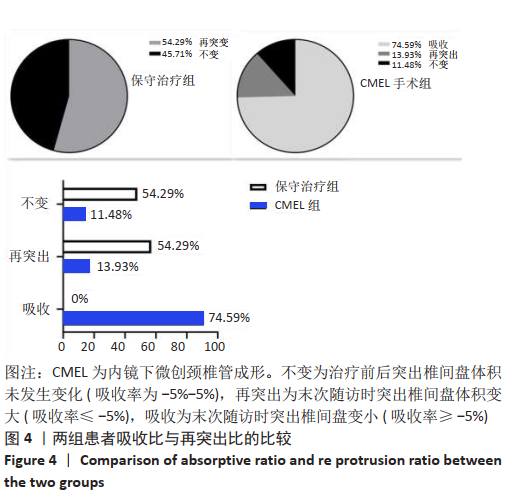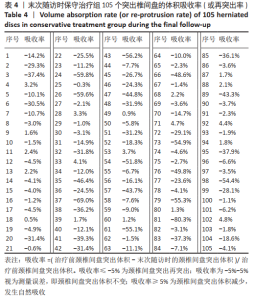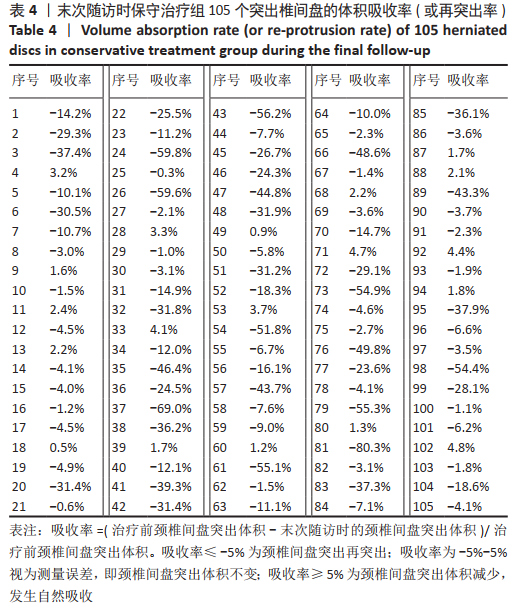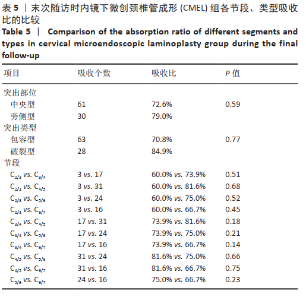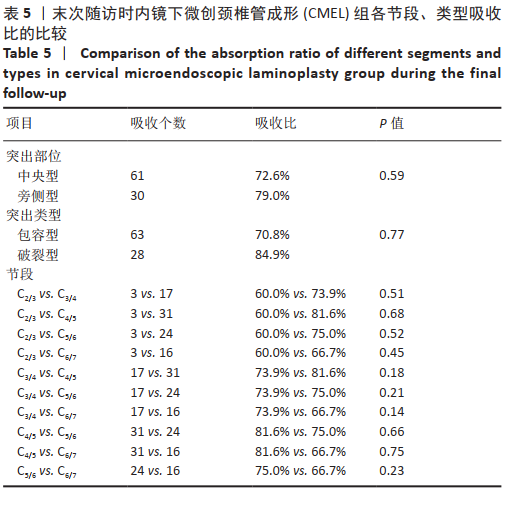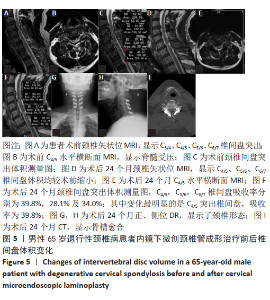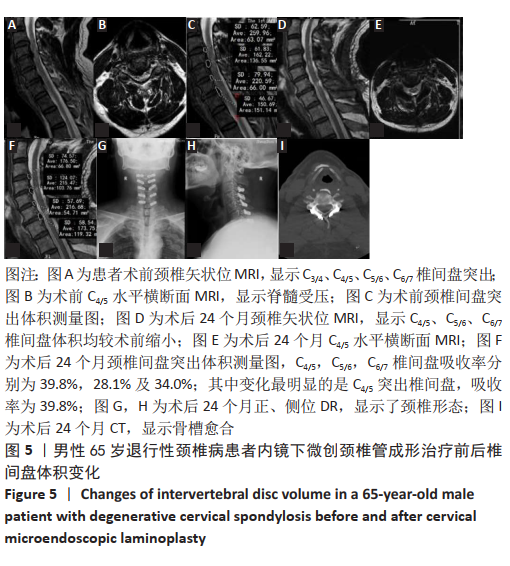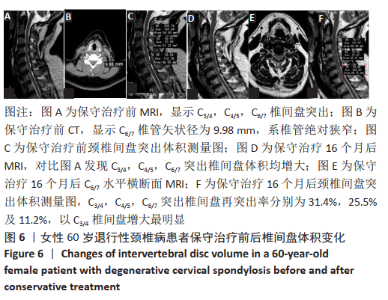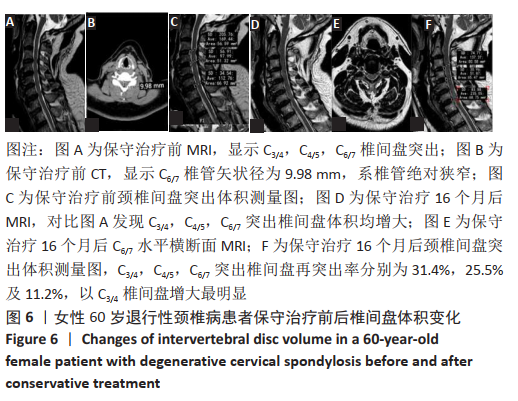Chinese Journal of Tissue Engineering Research ›› 2021, Vol. 25 ›› Issue (30): 4774-4780.doi: 10.12307/2021.260
Previous Articles Next Articles
Cervical microendoscopic laminoplasty and intervertebral disc resorption after conservative treatment assessed with three-dimensional volume method
Zhang Chunlin, Zhao Xiao, Yan Xu, Ning Yongming, Cao Zhengming
- Department of Orthopedics, First Affiliated Hospital of Zhengzhou University, Zhengzhou 450000, Henan Province, China
-
Received:2020-10-12Revised:2020-10-13Accepted:2020-12-31Online:2021-10-28Published:2021-07-29 -
Contact:Zhang Chunlin, MD, Professor, Chief physician, Department of Orthopedics, First Affiliated Hospital of Zhengzhou University, Zhengzhou 450000, Henan Province, China -
About author:Zhang Chunlin, MD, Professor, Chief physician, Master's supervisor, Department of Orthopedics, First Affiliated Hospital of Zhengzhou University, Zhengzhou 450000, Henan Province, China
CLC Number:
Cite this article
Zhang Chunlin, Zhao Xiao, Yan Xu, Ning Yongming, Cao Zhengming. Cervical microendoscopic laminoplasty and intervertebral disc resorption after conservative treatment assessed with three-dimensional volume method[J]. Chinese Journal of Tissue Engineering Research, 2021, 25(30): 4774-4780.
share this article
Add to citation manager EndNote|Reference Manager|ProCite|BibTeX|RefWorks
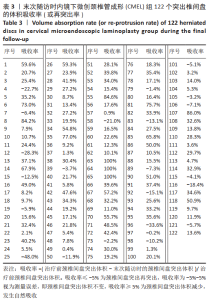
吸收比:CMEL组35例患者共有122个突出颈椎间盘,其中91个发生突出椎间盘吸收,即吸收比为74.6%,吸收率为5%-100%;保守治疗组33例患者共有105个突出颈椎间盘,其中共19个发生吸收,但吸收率均<5%,视为测量误差,予以忽略,即未观察到突出椎间盘再吸收的现象。两组吸收比相比差异有显著性意义(P < 0.01),见表2。 再突出比:CMEL组中17个椎间盘再突出,再突出比为13.9%,再突出率为5%-48%;保守治疗组中57个椎间盘再突出,再突出比为54.3%,再突出率为5.0%-80.3%。末次随访时两组再突出比相比差异有显著性意义(P < 0.01),见表2。 CMEL组11.5%的(14/122)突出椎间盘未发生变化(吸收率为-5%-5%),保守治疗组45.7%(48/105)的突出椎间盘未发生变化(吸收率为-5%-5%)。两组颈椎间盘突出吸收率数据详见表3,4。 "
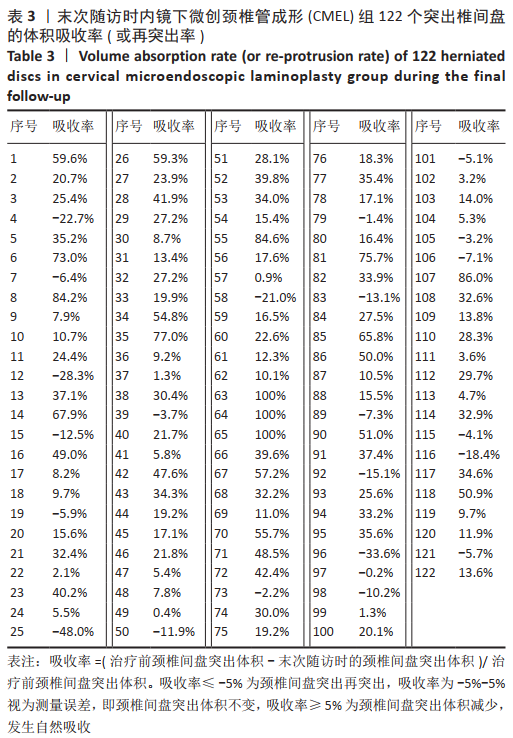
| [1] LEE NJ, KIM JS, PARK P, et al. A Comparison of Various Surgical Treatments for Degenerative Cervical Myelopathy: A Propensity Score Matched Analysis. Global Spine J. 2020:219256822097609. [2] CHEN G , LIU X , ZHAO E, et al. Comparative Five-Year Surgical Outcomes of Open-Door versus French-Door Laminoplasty in Multilevel Cervical Spondylotic Myelopathy. Biomed Res Int. 2020;2020:8853733. [3] PARTHIBAN J, ALVES OL, CHANDRACHARI KP, et al. Value of Surgery and Nonsurgical Approaches for Cervical Spondylotic Myelopathy: WFNS Spine Committee Recommendations. Neurospine. 2019;16(3):403-407. [4] CHEN G, LIU X, CHEN N, et al. Ten-Year Surgical Outcomes and Prognostic Factors for French-Door Laminoplasty in the Treatment of Multilevel Cervical Spondylotic Myelopathy. Biomed Res Int. 2020; 2020:3627071. [5] ZHANG C, LI D, WANG C, et al. Cervical Endoscopic Laminoplasty for Cervical Myelopathy. Spine (Phila Pa 1976). 2016;41 Suppl 19:B44-B51. [6] 张春霖,曾昭峰,唐恒涛,等. 标本模拟微创颈椎管成形后椎管容积变化及临床意义[J]. 中国组织工程研究,2013,17(26):4849-4856. [7] MOCHIDA K, KOMORI H, OKAWA A, et al. Regression of cervical disc herniation observed on magnetic resonance images. Spine. 1998; 23(9):990-995;discussion 996-997. [8] BBOEKEMA A, MOLENBERG R, KUIJLEN J, et al. The Odom Criteria: Validated at Last: A Clinimetric Evaluation in Cervical Spine Surgery. J Bone Joint Surg Am. 2019;101(14):1301-1308. [9] 张春霖,刘洋,尚利杰,等.基于PACS软件定量体积测量“监控”的突出颈椎间盘体积观察[J].中国组织工程研究,2020,24(18): 2888-2892. [10] KRIEGER AJ, MANIKER AH. MRI-documented regression of a herniated cervical nucleus pulposus: a case report. Surg Neurol. 1992;37:457-459. [11] KOBAYASHI N, ASAMOTO S, DOI H, et al. Spontaneous regression of herniated cervical disc. Spine J. 2003;3(2):171-173. [12] MAHAJAN PS, AL MOOSAWI NM, HASAN IA. A Rare Case of Near Complete Regression of a Large Cervical Disc Herniation without Any Intervention Demonstrated on MRI. Case Rep Radiol. 2014; 2014:832765. [13] HAN SR, CHOI CY. Spontaneous Regression of Cervical Disc Herniation: A Case Report. Korean J Spine. 2014;11(4):235-237. [14] KOÇYIĞIT A, MANISALI M, AKALIN E. Resorption of a Sequestrated Cervical Disc. Indian J Phys Med Rehabil. 2010. [15] MENG Y, WANG X, WANG B, et al. Aggravation and subsequent disappearance of cervical disc herniation after cervical open-door laminoplasty: A case report. Medicine (Baltimore). 2018;97(10):e0068. [16] 江雪莲. 腰椎间盘突出症MRI与CT诊断的临床价值对比分析[J]. 影像研究与医学应用,2018,2(9):17-19. [17] THELANDER U, FAGERLUND M, FRIBERG S, et al. Describing the size of lumbar disc herniations using computed tomography. A comparison of different size index calculations and their relation to sciatica. Spine (Phila Pa 1976). 1994;19(17):1979-1984. [18] MATSUMOTO M, CHIBA K, ISHIKAWA M, et al. Relationships Between Outcomes of Conservative Treatment and Magnetic Resonance Imaging Findings in Patients With Mild Cervical Myelopathy Caused by Soft Disc Herniations. Spine. 2001;26(14):1592-1598. [19] 张春霖,魏昱博,李东哲,等.内窥镜下微创颈椎管扩大成形术治疗多节段脊髓型颈椎病的中长期疗效[J].中国脊柱脊髓杂志,2018, 28(6):481-487. [20] TURK O, YALDIZ C. Spontaneous regression of cervical discs. Medicine (Baltimore). 2019;98(7):e14521. [21] MAHAJAN PS, AL MOOSAWI NM, HASAN IA. A Rare Case of Near Complete Regression of a Large Cervical Disc Herniation without Any Intervention Demonstrated on MRI. Case Rep Radiol. 2014;2014: 832765. [22] HAN SR, CHOI CY. Spontaneous Regression of Cervical Disc Herniation: A Case Report. Korean J Spine. 2014;11(4):235-237. [23] WANG HQ, YU XD, LIU ZH, et al. Deregulated miR-155 promotes Fas-mediated apoptosis in human intervertebral disc degeneration by targeting FADD and caspase-3. J Pathol. 2011;225:232-242. [24] SEO JY, ROH YH, KIM YH, et al. Three-dimensional analysis of volumetric changes in herniated discs of the lumbar spine: does spontaneous resorption of herniated discs always occur? Eur Spine J. 2016;25(5):1393-1402. [25] KESIKBURUN B, EKSIOGLU E, TURAN A, et al. Spontaneous regression of extruded lumbar disc herniation: Correlation with clinical outcome. Pak J Med Sci. 2019;35(4):974-980. [26] AJIBOYE RM, ZOLLER SD, ASHANA AA, et al. Regression of Disc-Osteophyte Complexes Following Laminoplasty Versus Laminectomy with Fusion for Cervical Spondylotic Myelopathy. Int J Spine Surg. 2017;11(3):17. [27] MACAGNO A, LIU S, MARASCALCHI BJ, et al. Perioperative Risks Associated with Cervical Spondylotic Myelopathy Based on Surgical Treatment Strategies. Int J Spine Surg. 2014;9:24. [28] THEODORE N. Degenerative Cervical Spondylosis. N Engl J Med. 2020; 383(2):159-168. [29] DAVIES BM, NOURALLAH B, VENKATESH A, et al. Establishing mild, moderate and severe criteria for the myelopathy disability index in cervical spondylotic myelopathy. Br J Neurosurg. 2020:1-5. [30] CHOI SH, KANG CN. Degenerative Cervical Myelopathy: Pathophysiology and Current Treatment Strategies. Asian Spine J. 2020;14(5):710-720. |
| [1] | Zhang Rui, Wang Kun, Shen Zicong, Mao Lu, Wu Xiaotao. Effects of endoscopic foraminoplasty and laminoplasty on biomechanical properties of intervertebral disc and isthmus [J]. Chinese Journal of Tissue Engineering Research, 2024, 28(6): 833-839. |
| [2] | Liu Wendong, Xia Hongle, Liu Lin, Shen Runbin, Guo Wei, Wang Xuyang, Li Guoliang. Three-dimensional digital model-assisted minimally invasive needle penetration and steel plate internal fixation in treatment of Sanders types II and III calcaneal fractures [J]. Chinese Journal of Tissue Engineering Research, 2024, 28(18): 2819-2824. |
| [3] | Wan Jian, Wang Ning, Bei Chaoyong, Chen Yuanming, Wang Honggang. Two lumbar fusion regimens in treatment of single-level lumbar degenerative diseases based on propensity score matching [J]. Chinese Journal of Tissue Engineering Research, 2024, 28(12): 1914-1919. |
| [4] | Chen Liuxu, Yang Han, Yang Jian, Yang Linyu, Kang Jianping. Finite element analysis of lumbar vertebra biomechanics after transforaminal lumbar interbody fusion combined with bilateral transpedicular transdiscal lumbar screw fixation [J]. Chinese Journal of Tissue Engineering Research, 2024, 28(12): 1815-1822. |
| [5] | Liu Jinyu, Zhang Hanshuo, Cui Hongpeng, Pan Lingzhi, Zhao Boran, Li Fei, Ding Yu. Finite element biomechanical analysis of minimally invasive treatment of cervical spondylotic myelopathy and accurate exercise rehabilitation [J]. Chinese Journal of Tissue Engineering Research, 2023, 27(9): 1359-1364. |
| [6] | Zhou Changjun, Long Shengli, Zou Wei, Xiao Jie, Long Hao, Feng Mingxing, Zhang Yang, Liu Jie, Zeng Zhongwei. Design and clinical application of coplanar screw guide for percutaneous pedicle screw in the treatment of thoracolumbar fracture [J]. Chinese Journal of Tissue Engineering Research, 2023, 27(4): 534-538. |
| [7] | Wang Ziyang, Zuo Enjun. Application of biological materials in vital pulp therapy [J]. Chinese Journal of Tissue Engineering Research, 2023, 27(3): 427-433. |
| [8] | Chen Xiao, He Binbin, Zhou Youliang, Zhao Liang, Zhang Xinguo, Jiang Ziyun, Shen Zhe. Comparison of reduction strength between long-arm single-axis pedicle screw fixation and single-plane pedicle screw fixation in the treatment of traumatic thoracolumbar fractures [J]. Chinese Journal of Tissue Engineering Research, 2023, 27(29): 4641-4646. |
| [9] | Sun Jun, Zhan Mingbin, Liu Xizhe, Liu Shaoyu. Comparison of the opening angle and cervical vertebra function of two different hinge rongeurs in French-door laminoplasty [J]. Chinese Journal of Tissue Engineering Research, 2023, 27(27): 4337-4344. |
| [10] | Jin Xinjie, Lu Xiangdong, Zhao Yibo, Zhao Xiaofeng, Qi Detai, Zhao Bin. Endoscopic transforaminal lumbar interbody fusion for degenerative diseases of the lumbar spine: decompression fusion and preservation of posterior spine anatomy [J]. Chinese Journal of Tissue Engineering Research, 2023, 27(27): 4401-4407. |
| [11] | Ling Xiaoming, Zhang Chunlin, Yan Xu, Shao Chenglong. Cervical microendoscopic laminoplasty remarkably improves cervical curvature in the treatment of the spinal cord line type III cervical spondylotic myelopathy [J]. Chinese Journal of Tissue Engineering Research, 2023, 27(22): 3555-3560. |
| [12] | Niu Cehao, Zhang Chunlin, Yan Xu, Fu Su, Feng Yang, Zhu Andi. Posterior vertebral structure and its influence on measurement of disc herniation volume [J]. Chinese Journal of Tissue Engineering Research, 2023, 27(18): 2897-2902. |
| [13] | Wang Suping, Qiu Demei, Fan Zhonghe, Hu Bo. Bibliometrics and visual analysis of research in the field of rehabilitation for femoroacetabular impingement syndrome in the past decade [J]. Chinese Journal of Tissue Engineering Research, 2023, 27(17): 2754-2762. |
| [14] | Lai Jieqing, Li Ruoyu, He Mincong, Lan Yun, Yang Xingfu, Zhou Nannan, Jiang Linheng, Lyu Zheng, Yi Chunzhi, Fang Bin. Clinical efficacy and biomechanical analysis of the tripod percutaneous reconstruction technique in periacetabular lesions caused by metastatic cancer [J]. Chinese Journal of Tissue Engineering Research, 2023, 27(13): 1987-1992. |
| [15] | Lu Pan, Zhang Chunlin, Wang Yongkui, Yan Xu, Dong Chao, Yue Yisen, Li Long, Zhu Andi. Volume changes of cervical herniated discs after open-door laminoplasty and conservative treatment as assessed by three-dimensional volume method [J]. Chinese Journal of Tissue Engineering Research, 2022, 26(9): 1395-1401. |
| Viewed | ||||||
|
Full text |
|
|||||
|
Abstract |
|
|||||
